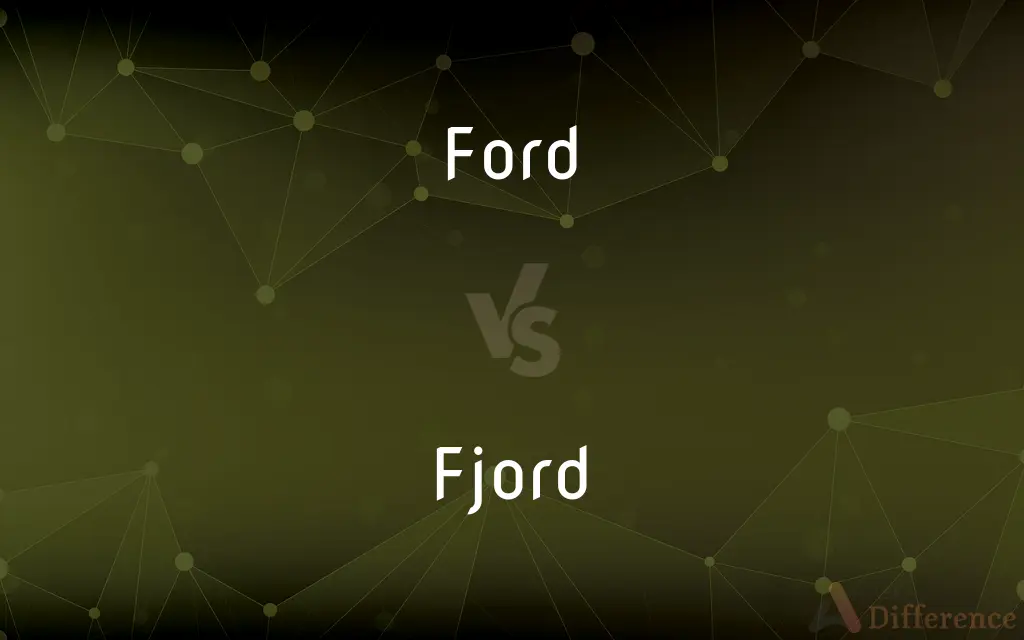Ford vs. Fjord — What's the Difference?
By Maham Liaqat & Fiza Rafique — Updated on April 5, 2024
Ford is a shallow place in a river or stream allowing one to walk or drive across, while a fjord is a long, narrow, deep inlet of the sea between high cliffs or steep slopes.

Difference Between Ford and Fjord
Table of Contents
ADVERTISEMENT
Key Differences
A ford is typically a natural or man-made crossing point on a river or stream that is shallow enough to be crossed by vehicles, animals, or people on foot without the need for a bridge. It's often found in rural areas and can be crucial for local transportation. On the other hand, a fjord is a geographical feature formed by the deep glacial erosion of the land then flooded by the sea, creating a narrow, deep inlet with steep land on three sides, typically found in regions with a history of glaciation, such as Norway.
While fords are primarily functional, serving as crossing points in rivers or streams, fjords are notable for their dramatic beauty and are often surrounded by breathtaking landscapes. Fjords can attract tourists, adventurers, and geologists interested in their formation and surrounding ecosystems, whereas fords are valued for their practicality in transportation and accessibility, especially in areas where bridges are not feasible.
The formation of a ford is a result of natural river processes or deliberate landscaping to create a shallow area in the water. This makes fords dependent on the river's water level, which can change with the seasons or weather conditions, potentially making them impassable at times. Fjords, however, are the result of the slow, erosive power of glaciers cutting through rock to create deep inlets that are then filled by rising sea levels, a process taking thousands to millions of years.
Fords have been used throughout history as important crossing points for armies, travelers, and trade routes, emphasizing the role of rivers in human civilization and the need to navigate them. Fjords, while also historically significant, especially to the Scandinavian cultures, have played more of a role in shaping the geography and settlement patterns of the regions they are found in, often serving as natural harbors.
In terms of environmental impact, the construction and use of fords have minimal effects on a river's ecosystem, provided they are carefully managed to avoid disrupting aquatic life and water quality. Fjords, being natural formations, support diverse ecosystems both above and below the water surface, including unique marine and terrestrial species adapted to the specific conditions of these environments.
ADVERTISEMENT
Comparison Chart
Definition
A shallow place in a river for crossing.
A deep, narrow sea inlet with steep sides.
Formation
Natural river processes or landscaping.
Glacial erosion followed by sea flooding.
Function
Serves as a crossing point.
Forms natural harbors and landscapes.
Location
Found in rivers and streams.
Found in glaciated regions.
Significance
Important for transportation and accessibility.
Notable for beauty, tourism, and geology.
Compare with Definitions
Ford
To cross a river or stream at a shallow place.
The pioneers forded the river successfully with their wagons.
Fjord
An inlet of the sea characterized by its steep land on three sides, often with a river flowing into it.
The fjord was alive with wildlife, from eagles soaring above to fish teeming in the waters.
Ford
To accomplish the crossing of a river or stream by wading.
They had to ford several streams on their journey through the wilderness.
Fjord
A scenic waterway, often used for recreation, tourism, and study of glacial geology.
Kayaking through the fjord, they marveled at the sheer cliffs and waterfalls cascading down to the sea.
Ford
A shallow part of a river or stream that can be crossed by walking, riding, or driving through the water.
They decided to cross the river at the ford where the water was lowest.
Fjord
A long, narrow, deep inlet of the sea between high cliffs, typically formed by the submergence of a glaciated valley.
The fjord's waters were deep and calm, surrounded by towering cliffs.
Ford
A place where a river or stream can be crossed without a bridge.
The map showed a ford ahead, which was good news for the hikers.
Fjord
A geographic feature found in glaciated areas, offering spectacular natural landscapes.
Norway is famous for its dramatic fjords that attract tourists from around the world.
Ford
A crossing point in a body of water, used historically for trade routes and military campaigns.
The army chose to attack through the less guarded mountain pass and the river ford.
Fjord
A natural harbor created by the unique topography of glaciated valleys.
The village nestled at the fjord's edge has been a fishing community for centuries.
Ford
A shallow place in a body of water, such as a river, where one can cross by walking or riding on an animal or in a vehicle.
Fjord
In geology, a fjord or fiord (alternatively fyord) ( (listen)) is a long, narrow inlet with steep sides or cliffs, created by a glacier. There are many fjords on the coasts of Alaska, Antarctica, British Columbia, Chile, Denmark, Greenland, the Faroe Islands, Iceland, Ireland, Kamchatka, the Kerguelen Islands, New Zealand, Norway, Novaya Zemlya, Labrador, Nunavut, Newfoundland, Quebec, Scotland, South Georgia Island, Isla de los Estados, and Washington state.
Ford
To cross (a body of water) at a ford.
Fjord
A long, narrow, deep inlet of the sea between high cliffs, as in Norway, typically formed by submergence of a glaciated valley.
Ford
A location where a stream is shallow and the bottom has good footing, making it possible to cross from one side to the other with no bridge, by walking, riding, or driving through the water; a crossing.
Fjord
A long, narrow, deep inlet of the sea between steep slopes, especially one shaped by glacial action.
Ford
A stream; a current.
Fjord
A long, narrow, deep inlet between cliffs.
Ford
To cross a stream using a ford.
Fjord
See Fiord.
Ford
A place in a river, or other water, where it may be passed by man or beast on foot, by wading.
He swam the Esk river where ford there was none.
Fjord
A long narrow inlet of the sea between steep cliffs; common in Norway
Ford
A stream; a current.
With water of the fordOr of the clouds.
Permit my ghost to pass the Styg an ford.
Ford
To pass or cross, as a river or other water, by wading; to wade through.
His last section, which is no deep one, remains only to be forted.
Ford
United States film maker (1896-1973)
Ford
Grandson of Henry Ford (1917-1987)
Ford
Son of Henry Ford (1893-1943)
Ford
English writer and editor (1873-1939)
Ford
38th President of the United States; appointed Vice President and succeeded Nixon when Nixon resigned (1913-)
Ford
United States manufacturer of automobiles who pioneered mass production (1863-1947)
Ford
A shallow area in a stream that can be forded
Ford
The act of crossing a stream or river by wading or in a car or on a horse
Ford
Cross a river where it's shallow
Common Curiosities
What makes fjords unique compared to other landscapes?
Fjords are unique for their dramatic and steep landscapes created by glacial activity, often featuring rich biodiversity.
How are fjords formed?
Fjords are formed by the action of glaciers eroding the land, then filled with sea water as the glaciers melt.
Can you drive through a fjord?
No, fjords are deep waterways. You can drive along them but not through them; for crossing, ferries or bridges are used.
Can fjords be found in any part of the world?
Fjords are primarily found in regions with a history of glaciation, such as Norway, New Zealand, and Canada.
Why are fords important in history?
Fords have been crucial for transportation, trade, and military movements before the widespread construction of bridges.
How do ecosystems in fjords differ from those in other marine environments?
Fjord ecosystems are often more isolated, with unique species and conditions due to the deep, cold waters and steep cliffs.
Are there man-made fords?
Yes, some fords are man-made to improve the accessibility of rivers or streams at specific points.
What distinguishes a ford from a fjord?
A ford is a shallow place in a river for crossing, while a fjord is a deep, narrow sea inlet formed by glaciers.
How do fjords affect local climates?
The high cliffs of fjords can create microclimates, often cooler and wetter, and can affect local weather patterns.
What is the significance of fords in modern times?
Fords remain relevant in rural or undeveloped areas where bridges are not feasible, providing vital crossing points.
Share Your Discovery

Previous Comparison
Marketing vs. Commercial
Next Comparison
Elvan vs. ElvenAuthor Spotlight
Written by
Maham LiaqatCo-written by
Fiza RafiqueFiza Rafique is a skilled content writer at AskDifference.com, where she meticulously refines and enhances written pieces. Drawing from her vast editorial expertise, Fiza ensures clarity, accuracy, and precision in every article. Passionate about language, she continually seeks to elevate the quality of content for readers worldwide.













































